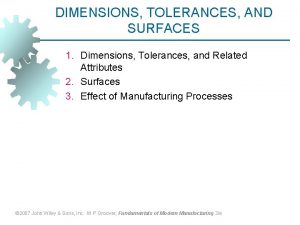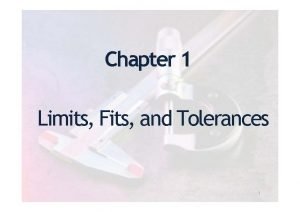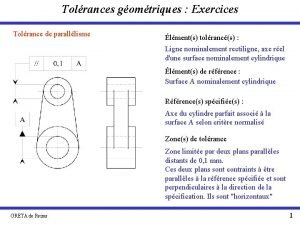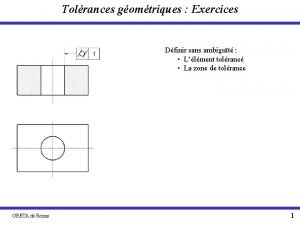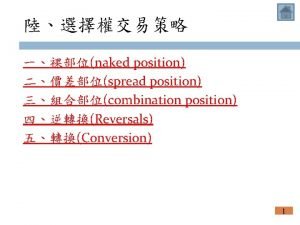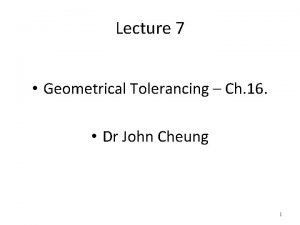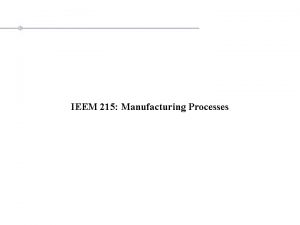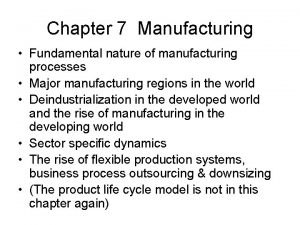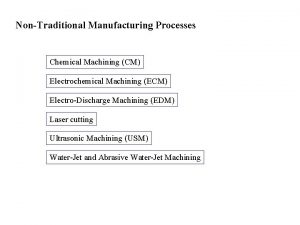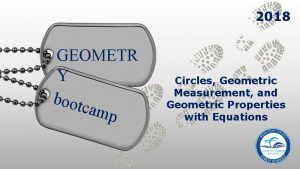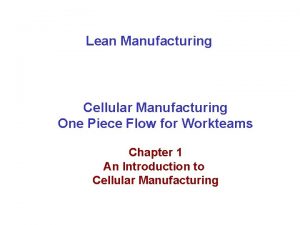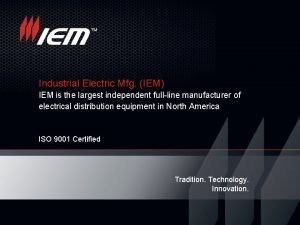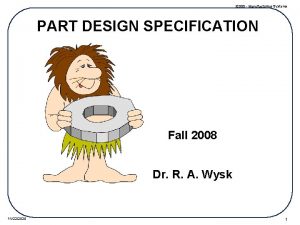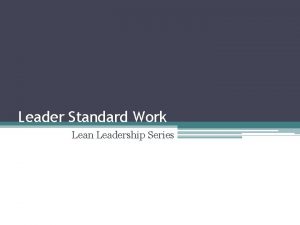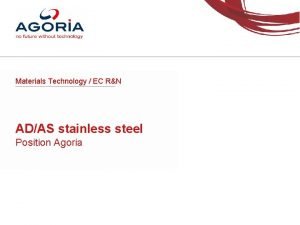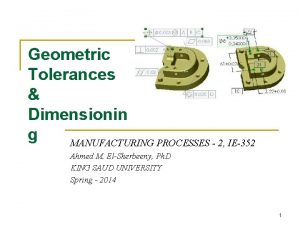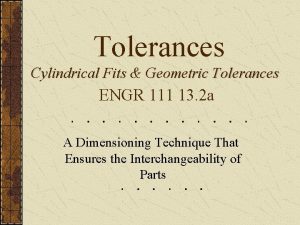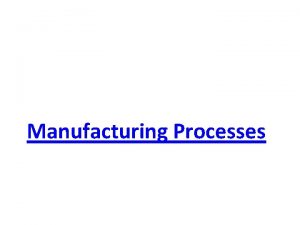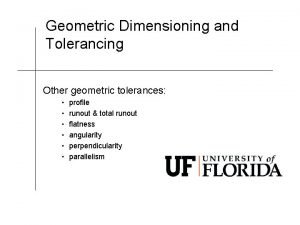Geometric Tolerances Dimensionin g MANUFACTURING PROCESSES 2 IE352





































- Slides: 37

Geometric Tolerances & Dimensionin g MANUFACTURING PROCESSES - 2, IE-352 Ahmed M. El-Sherbeeny, Ph. D KING SAUD UNIVERSITY Spring - 2014 1

Content n n n Overview Form tolerances Orientation tolerances Location tolerances Wrapping up

ANSI Y 14. 5 -1994 Standard This standard establishes uniform practices for defining and interpreting dimensions, and tolerances, and related requirements for use on engineering drawings. The figures in this presentation are taken from Bruce Wilson’s Design Dimensioning and Tolerancing.

Geometric Tolerancing n What is Geometric tolerancing used for? Geometric Tolerancing is used to specify the shape of features. Things like: Straightness n Flatness n Circularity n Cylindricity n Angularity n Profiles n Perpendicularity n Parallelism n Concentricity And More. . . n

Overview of Geometric Tolerances Geometric tolerances define the shape of a feature as opposed to its size. We will focus on three basic types of geometric tolerances: 1. Form tolerances: straightness, circularity, flatness, cylindricity; 2. Orientation tolerances; perpendicularity, parallelism, angularity; 3. Location tolerances: position, symmetry, concentricity.

Symbols for Geometric Tolerances Form Orientation Location

Most Common Symbols

Feature Control Frame A geometric tolerance is prescribed using a feature control frame. It has three components: 1. the tolerance symbol, 2. the tolerance value, 3. the datum labels for the reference frame.

Feature Control Frame n How do you read this feature control frame? “The specified feature must lie perpendicular within a tolerance zone of 0. 05 diameter at the maximum material condition, with respect to datum axis C. ” In other words, this places a limit on the amount of variation in perpendicularity between the feature axis and the datum axis. In a drawing, this feature control frame would accompany dimensional tolerances that control the feature size and position.

Reference Frame A reference frame is defined by three perpendicular datum planes. The left-to-right sequence of datum planes defines their order of precedence.

Order of Precedence The part is aligned with the datum planes of a reference frame using 3 -2 -1 contact alignment. • 3 points of contact align the part to the primary datum plane; • 2 points of contact align the part to the secondary datum plane; • 1 point of contact aligns the part with the tertiary datum plane

Using a Feature as a Datum A feature such as a hole, shaft, or slot can be used as a datum. In this case, the datum is theoretical axis, centerline, or center plane of the feature. The “circle M” denotes the datum is defined by the Maximum Material Condition (MMC) given by the tolerance.

Material Conditions • Maximum Material Condition (MMC): The condition in which a feature contains the maximum amount of material within the stated limits. e. g. minimum hole diameter, maximum shaft diameter. • Least Material Condition (LMC): The condition in which a feature contains the least amount of material within the stated limits. e. g. maximum hole diameter, minimum shaft diameter • Regardless of Feature Size (RFS): This is the default condition for all geometric tolerances. No bonus tolerances are allowed and functional gauges may not be used.

Material Conditions ANSI Y 14. 5 M RULE #1: A dimensioned feature must have perfect form at its maximum material condition. This means: • A hole is a perfect cylinder when it is at its smallest permissible diameter, • A shaft is a perfect cylinder when at its largest diameter. • Planes are perfectly parallel when at their maximum distance. ANSI Y 14. 5 M RULE #2: If no material condition is specified, then it is “regardless of feature size. ”

Material Conditions n Which one is which?

Straightness of a Shaft • A shaft has a size tolerance defined for its fit into a hole. A shaft meets this tolerance if at every point along its length a diameter measurement falls within the specified values. • This allows the shaft to be bent into any shape. A straightness tolerance on the shaft axis specifies the amount of bend allowed.

Straightness of a Shaft • Add the straightness tolerance to the maximum shaft size (MMC) to obtain a “virtual condition” Vc, or virtual hole, that the shaft must fit to be acceptable.

Straightness of a Hole • The size tolerance for a hole defines the range of sizes of its diameter at each point along the centerline. This does not eliminate a curve to the hole. • The straightness tolerance specifies the allowable curve to the hole. • Subtract the straightness tolerance from the smallest hole size (MMC) to define the virtual condition Vc, or virtual shaft, that must fit the hole for it to be acceptable.

Straightness of a Center Plane • The size dimension of a rectangular part defines the range of sizes at any cross-section. • The straightness tolerance specifies the allowable curve to the entire side. • Add the straightness tolerance to the maximum size (MMC) to define a virtual condition Vc that the part must fit into in order to meet the tolerance.

Flatness, Circularity and Cylindricity The flatness tolerance defines a distance between parallel planes that must contain the highest and lowest points on a face.

Flatness, Circularity and Cylindricity The circularity tolerance defines a pair of concentric circles that must contain the maximum and minimum radius points of a circle.

Flatness, Circularity and Cylindricity The cylindricity tolerance defines a pair of concentric cylinders that must contain the maximum and minimum radius points along a cylinder.

Parallelism Tolerance A parallelism tolerance is measured relative to a datum specified in the control frame. If there is no material condition (i. e. . regardless of feature size), then the tolerance defines parallel planes that must contain the maximum and minimum points on the face.

Parallelism Tolerance If MMC is specified for the tolerance value: • If it is an external feature, then the tolerance is added to the maximum dimension to define a virtual condition that the part must fit; • If it is an internal feature, then the tolerance is subtracted to define the maximum dimension that must fit into the part.

Perpendicularity A perpendicular tolerance is measured relative to a datum plane. It defines two planes that must contain all the points of the face. A second datum can be used to locate where the measurements are taken.

Perpendicular Shaft, Hole, and Center Plane • Shaft: The maximum shaft size plus the tolerance defines the virtual hole.

Perpendicular Shaft, Hole, and Center Plane Hole: The minimum hole size minus the tolerance defines the virtual shaft.

Perpendicular Shaft, Hole, and Center Plane: The tolerance defines the variation of the location of the center plane.

Angularity An angularity tolerance is measured relative to a datum plane. It defines a pair of planes that must 1. contain all the points on the angled face of the part, or 2. if specified, the plane tangent to the high points of the face.

Position Tolerance for a Hole • The position tolerance for a hole defines a zone that has a defined shape, size, location and orientation. • It has the diameter specified by the tolerance and extends the length of the hole. • Basic dimensions locate theoretically exact center of the hole and the center of the tolerance zone. • Basic dimensions are measured from the datum reference frame.

Material Condition Modifiers MMC: If the tolerance zone is prescribed for the maximum material condition (smallest hole), then the zone expands by the same amount that the hole is larger in size. Use MMC for holes used in clearance fits.

Material Condition Modifiers RFS: No material condition modifier means the tolerance is “regardless of feature size. ” Use RFS for holes used in interference or press fits.

Position Tolerance on a Hole Pattern A composite control frame signals a tolerance for a pattern of features, such as holes. • The first line defines the position tolerance zone for the holes. • The second line defines the tolerance zone for the pattern, which is generally smaller.

Datum Reference in a Composite Tolerance A datum specification for the pattern only specifies the orientation of the pattern tolerance zones. Primary datum specified.

Datum Reference in a Composite Tolerance No datum for the pattern

Summary Ø Geometric tolerances are different from the tolerances allowed for the size of feature, they specify the allowable variation of the shape of a feature. Ø There are three basic types of geometric tolerances: Form, Orientation and Position tolerances. Ø Geometric tolerances are specified using a control frame consisting of a tolerance symbol, a tolerance value and optional datum planes. Ø Material condition modifiers define the condition at which the tolerance is to be applied. If the maximum material condition is specified, then there is a “bonus tolerance” associated with a decrease in material. 1. The form of a feature is assumed to be perfect at its maximum material condition. 2. If no material condition is specified, then it is regard less of feature size.

Additional materials n n http: //www. engineersedge. com/tolerance__calc_menu. shtml http: //www. engineersedge. com/gdt. htm
 Bilateral tolerance
Bilateral tolerance Fits and tolerance شرح
Fits and tolerance شرح Exercice tolérance géométrique
Exercice tolérance géométrique Bilateral vs unilateral tolerance
Bilateral vs unilateral tolerance Tolérances géométriques
Tolérances géométriques Limits fits and tolerances
Limits fits and tolerances Position tolerances
Position tolerances Geometric characteristic symbols
Geometric characteristic symbols Geometrical tolerances
Geometrical tolerances Process vs job costing
Process vs job costing Manufacturing cost vs non manufacturing cost
Manufacturing cost vs non manufacturing cost Manufacturing cost vs non manufacturing cost
Manufacturing cost vs non manufacturing cost Manufacturing cost vs non manufacturing cost
Manufacturing cost vs non manufacturing cost Additive manufacturing steps
Additive manufacturing steps Classification of production system
Classification of production system Manufacturing processes for engineering materials 5th
Manufacturing processes for engineering materials 5th Similar
Similar Introduction to manufacturing process
Introduction to manufacturing process Industrial revolution transition
Industrial revolution transition Composite manufacturing processes
Composite manufacturing processes Nature of manufacturing process
Nature of manufacturing process Nontraditional manufacturing processes
Nontraditional manufacturing processes Concurrent in os
Concurrent in os 2018 geometry bootcamp answers
2018 geometry bootcamp answers Benefits of ict in design and manufacturing
Benefits of ict in design and manufacturing Lean manufacturing definition
Lean manufacturing definition One piece flow
One piece flow Industrial electric mfg
Industrial electric mfg Assembly tolerance
Assembly tolerance Qualex manufacturing
Qualex manufacturing Features of manufacturing account
Features of manufacturing account Additive and subtractive modeling
Additive and subtractive modeling Komatsu supplier portal
Komatsu supplier portal Ee
Ee Lean manufacturing tier meetings
Lean manufacturing tier meetings Configure to order example
Configure to order example R&n steel building manufacturing
R&n steel building manufacturing Vanderman manufacturing company
Vanderman manufacturing company
